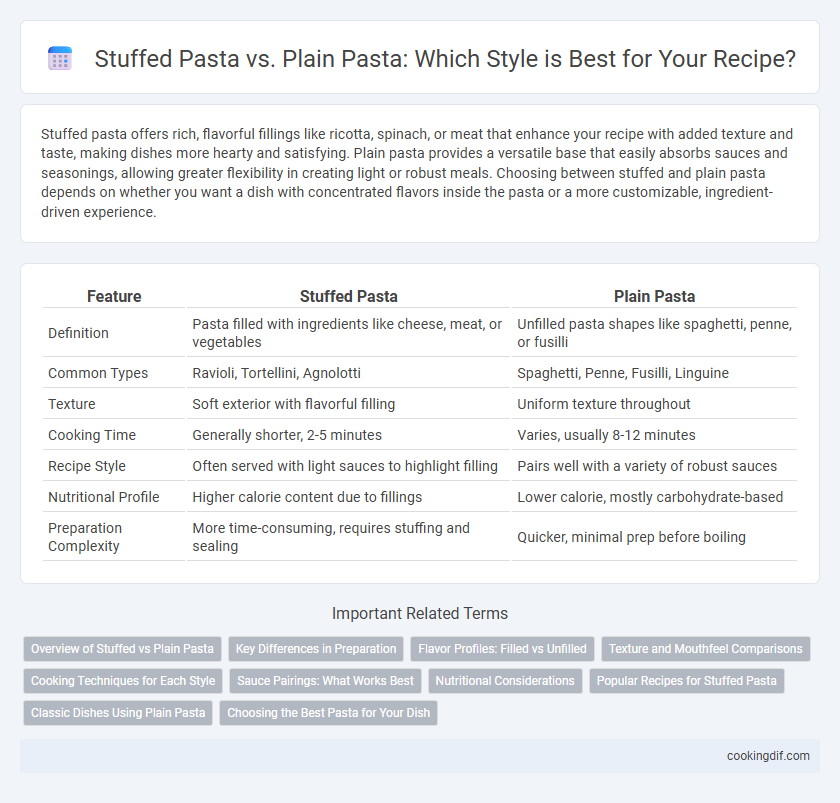Stuffed pasta offers rich, flavorful fillings like ricotta, spinach, or meat that enhance your recipe with added texture and taste, making dishes more hearty and satisfying. Plain pasta provides a versatile base that easily absorbs sauces and seasonings, allowing greater flexibility in creating light or robust meals. Choosing between stuffed and plain pasta depends on whether you want a dish with concentrated flavors inside the pasta or a more customizable, ingredient-driven experience.
Table of Comparison
| Feature | Stuffed Pasta | Plain Pasta |
|---|---|---|
| Definition | Pasta filled with ingredients like cheese, meat, or vegetables | Unfilled pasta shapes like spaghetti, penne, or fusilli |
| Common Types | Ravioli, Tortellini, Agnolotti | Spaghetti, Penne, Fusilli, Linguine |
| Texture | Soft exterior with flavorful filling | Uniform texture throughout |
| Cooking Time | Generally shorter, 2-5 minutes | Varies, usually 8-12 minutes |
| Recipe Style | Often served with light sauces to highlight filling | Pairs well with a variety of robust sauces |
| Nutritional Profile | Higher calorie content due to fillings | Lower calorie, mostly carbohydrate-based |
| Preparation Complexity | More time-consuming, requires stuffing and sealing | Quicker, minimal prep before boiling |
Overview of Stuffed vs Plain Pasta
Stuffed pasta varieties like tortellini and ravioli offer complex flavors and textures due to their fillings, making them ideal for rich, hearty recipes. Plain pasta types, such as spaghetti and penne, provide a neutral base that easily complements a wide range of sauces and ingredients, allowing versatility in recipe creation. Choosing between stuffed and plain pasta depends on the desired depth of flavor and the overall complexity of the dish.
Key Differences in Preparation
Stuffed pasta requires meticulous preparation involving dough rolling, filling, and sealing each piece, whereas plain pasta focuses primarily on dough shaping or cutting without fillings. The preparation of stuffed pasta often demands additional steps like creating fillings from cheese, meat, or vegetables, altering cooking times to accommodate the filling's texture. Plain pasta recipes typically emphasize dough consistency and drying processes to achieve the desired texture and cooking performance.
Flavor Profiles: Filled vs Unfilled
Stuffed pasta offers complex flavor profiles by combining fillings like ricotta, spinach, or meat with seasoned dough, creating a harmonious blend of textures and tastes in each bite. Plain pasta serves as a neutral base that highlights the accompanying sauces, allowing ingredients like tomato, garlic, or cream to take center stage. Choosing between stuffed and unfilled pasta depends on whether the recipe aims to emphasize integrated fillings or enhance the sauce's flavor.
Texture and Mouthfeel Comparisons
Stuffed pasta features a tender outer dough encasing flavorful fillings, offering a multi-textural experience that combines the softness of the pasta with the creamy or chunky consistency inside. Plain pasta provides a uniform, al dente bite that emphasizes the sauce's texture without the added complexity of fillings. The contrast in mouthfeel between stuffed pasta's rich, moist interior and plain pasta's simple, chewy structure defines their unique roles in recipe styles.
Cooking Techniques for Each Style
Stuffed pasta such as ravioli and tortellini requires precise sealing techniques and shorter boiling times to prevent filling leakage and ensure even cooking. Plain pasta like spaghetti or penne benefits from al dente boiling followed by sauteing or tossing with sauces to enhance texture and flavor absorption. Mastery of temperature control and timing is essential for optimizing the distinct textures and taste profiles of each pasta style.
Sauce Pairings: What Works Best
Stuffed pasta like ravioli and tortellini pairs well with light, creamy sauces or simple butter and sage to complement fillings without overpowering them. Plain pasta such as spaghetti or penne works best with robust tomato-based or hearty meat sauces that cling to the noodles and enhance their texture. Choosing the right sauce for the pasta type ensures balanced flavors and an optimal dining experience.
Nutritional Considerations
Stuffed pasta like ravioli or tortellini often contains cheese, meat, or vegetables, increasing protein, fat, and calorie content compared to plain pasta, which is primarily a carbohydrate source. Plain pasta provides a versatile base for nutrient-dense sauces and toppings, allowing better control over sodium and fat intake. Selecting whole-grain plain pasta can boost fiber content, whereas stuffed pasta may offer more balanced macronutrients but higher sodium levels due to filling ingredients.
Popular Recipes for Stuffed Pasta
Stuffed pasta, such as ravioli and tortellini, offers a rich variety of popular recipes that combine flavorful fillings like ricotta, spinach, and meat blends, enhancing the overall taste experience compared to plain pasta. Classic dishes like spinach and ricotta stuffed ravioli with sage butter sauce or tortellini in creamy Alfredo sauce highlight the versatility of stuffed pasta in gourmet cooking. These recipes emphasize the balance between the pasta dough and the filling, creating a satisfying texture that plain pasta recipes typically lack.
Classic Dishes Using Plain Pasta
Classic dishes using plain pasta often highlight simple yet rich flavors, such as Spaghetti Carbonara, Fettuccine Alfredo, and Penne Arrabbiata, where the pasta's texture complements hearty sauces. Plain pasta varieties like spaghetti, fettuccine, and penne provide versatile foundations that absorb sauces effectively without overwhelming the dish. Unlike stuffed pasta, which specializes in filled centers offering a burst of flavor, plain pasta emphasizes sauce integration and ingredient harmony in traditional recipes.
Choosing the Best Pasta for Your Dish
Stuffed pasta, such as ravioli or tortellini, delivers a rich, flavorful bite with fillings like cheese, meat, or vegetables, ideal for recipes requiring a hearty and textured profile. Plain pasta, including spaghetti or penne, offers versatility and absorbs sauces efficiently, making it suitable for lighter, sauce-centric dishes. Selecting the best pasta depends on the intended flavor intensity and sauce compatibility to enhance your recipe's overall taste and presentation.
Stuffed pasta vs plain pasta for recipe style Infographic

 cookingdif.com
cookingdif.com